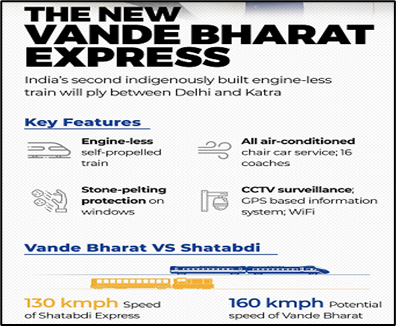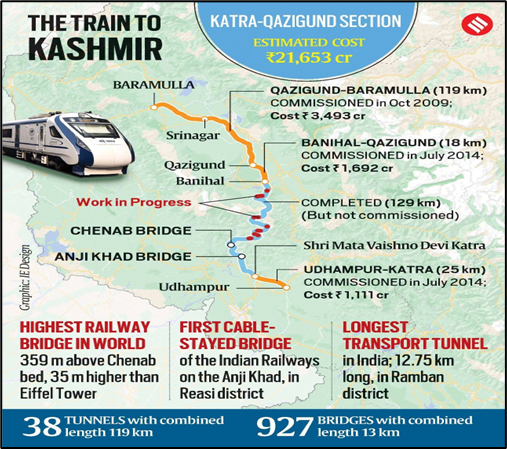Why in News?
- According to the Union Railway Ministry, a Vande Bharat Express will run between Jammu and Kashmir soon as the work on the 272-km Udhampur-Srinagar-Baramulla Railway Line (USBRL) is completed.
What’s in Today’s Article?
- About the Vande Bharat Express
- The Vande Bharat Express in Jammu and Kashmir (History, Challenges, Safety and Security, Benefits)
About the Vande Bharat Express:
- Formerly known as Train 18, it is an electric multiple-unit, low cost, semi-high speed train designed by Research Designs & Standards Organisation (RDSO), manufactured by the Integral Coach Factory (ICF, Chennai) and operated by Indian Railways.
- The train has achieved a maximum speed of 180 km/h (110 mph) and went into service on 15 February 2019 (New Delhi- Kanpur-Allahabad-Varanasi route).
- The latest (12 April, 2023) and 15th Vande Bharat Express train will ply between Jaipur and Delhi Cantt railway station.
- It was made with low-cost maintenance and operational optimisation in mind.

The Vande Bharat Express in Jammu and Kashmir:

History of the project:
- The first railway line in the former princely state of Jammu and Kashmir was built by the British in 1897 over a distance of 40-45 km between Jammu and Sialkot in the plains.
- After Partition, Sialkot went to Pakistan, and Jammu was disconnected from the rail network of India.
- Until the inauguration of the Pathankot-Jammu line in 1975, the railway station nearest to Jammu and Kashmir was Pathankot in Punjab.
- In 1983, work began on a railway line between Jammu and Udhampur. The project was completed in 2004 and has 20 major tunnels, and 158 bridges.
- With work underway on the Jammu-Udhampur line, the government approved (1995) the extension of the line from Udhampur to Srinagar, and then Baramulla - USBRL project.
- The project was declared (2002) as a national project on account of its being among the most challenging works undertaken by the Indian Railways after Independence.
Challenges and innovations:
- The Himalayas are young and the geologically unstable Shivalik Hills and Pir Panjal mountains lie in the seismically most active Zones IV and V.
- The terrain, which sees heavy snow in winter, presents serious challenges in the construction of bridges and tunnels.
- In view of the challenges in the construction, engineers of the Railways devised a novel Himalayan Tunneling Method (HTM).
- Under this, horseshoe-shaped tunnels were constructed instead of the usual D-shaped ones.
- The site comes down in a curve giving strength to the structure where the soil above it is loose.
- The broad-gauge railway line will have 5-1% ruling gradient, avoiding the need for bank engines in a mountainous region.
- The trains will be powered by diesel locomotives for now, but there is a provision for electrification in the future.
- Trains can run at speeds up to 100 km/h for the entire length of the journey.
Safety and security:
- All the major bridges, tunnels, and railway stations will be illuminated and have CCTV
- The track and tunnels have been designed to require as little maintenance as possible.
Development benefits:
- It will bring down the travel time between Srinagar and Jammu to between three and three-and-a-half hours from the five to six hours that it takes by road currently.
- It will provide a reliable and cost-effective all-weather alternative to the Jammu-Srinagar national highway that is frequently shut down by landslides.
- It will facilitate hassle-free transport of goods such as apples, dry fruits, pashmina shawls, handicrafts etc., to other parts of the country in the shortest possible time and at lesser cost.
- Four cargo terminals will be built between Banihal and Baramulla, land has been identified for three of these terminals.










